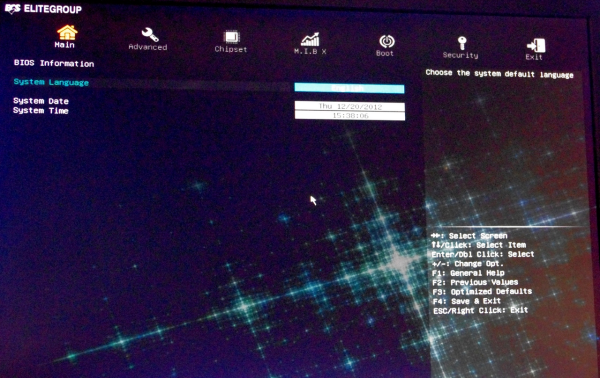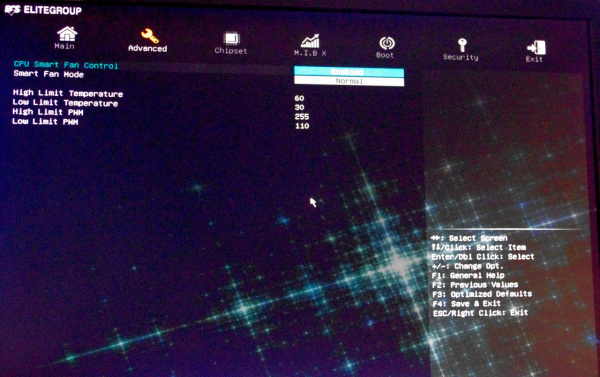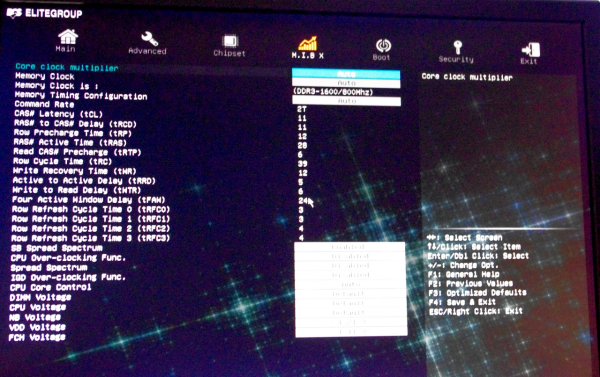ECS A85F2-A Golden Review: All That Glitters
by Ian Cutress on January 12, 2013 11:30 AM EST- Posted in
- Motherboards
- ECS
- FM2
- A85X
Whenever a lower-tier manufacturer sends me a board for review, I always know in the back of my mind that resources are not always plentiful. ECS sells ~6-8 million motherboards a year, but most (75%+) are to OEMs and thus their own channel team is actually fairly small. I would not be surprised if the combined BIOS and software teams numbered more than 4 or 5. This unfortunately can have a detrimental affect on the quality of the BIOS and software, which over time may not be updated, and left in limbo / a poor state of user experience. I have to treat each motherboard on the same level when it comes to reviews, with no benefit of the doubt when compared to the competition – if there are flaws that cannot be circumnavigated then the price/warranty/box contents are often the deciding factors.
With ECS’ efforts since graphical BIOSes came to the mainstream markets, they have gone through several stages - a basic version followed by a reasonably designed aesthetic edition and on to implementing an easy mode. The new Easy Mode for ECS actually looks like something futuristic:
Gone are the white and blues with a touch of green, with the blue backgrounds exchanged for a starry black background similar to that used by ASRock. The front screen as we go onto the BIOS is a great example of how a graphical BIOS can be used – colors, options, and information all being top priority. We are given the Motherboard model name, the BIOS version, the CPU installed, the memory installed, the important voltages, fan speeds, and a funky thing in the middle that says ‘CPU Offset’, which as far as I can tell relates to the temperature. Aside from this naming issue, we get options to put the machine into several modes – Normal, Performance, Power and Quiet, each using the internal options to adjust features to improve processing power, reduce power usage, or reduce fan speeds. Elsewhere on this screen is also a boot priority list and language selection. At the top right is our button to go into the Advanced Mode.
Unfortunately the Advanced mode has taken a step back from the previous ECS BIOSes we have exampled. The icons are dull, and the inverse contrast color scheme can be highly frustrating in low light scenarios. Our front screen in the advanced menus is very bland, despite the fact that, in my view, it should have all the information given in the easy mode as well. All we get here is a language option and the system time and date.
The ‘Advanced’ tab on the top menu list gives various options related to the controllers on board, such as LAN configuration, CPU Configuration, SATA, USB, Super IO et al. The fan controls are hidden under ‘PC Health Status -> Smart Fan Function’, and only the CPU Fan is actually adjustable.
Users can set the top and bottom points of a gradient in terms of speed and power to the fan header. Power to the fan header is given as a number between 0 and 255 (the ‘PWM value’), although as we have mentioned previously in reviews, the fan speed of a fan is never directly proportional to the power provided, making this system the easiest way out of the ‘we must provide fan controls’ situation.
Under the Chipset tab are a few options split between ‘North Bridge’ and ‘South Bridge’. Selecting North Bridge gives the integrated GPU options as well as the ability to enable a Hybrid CrossFireX situation. South Bridge contains audio codec options.
The next tab along is M.I.B X, the ECS BIOS overclocking options. Rather than separate the overclocking options out into various sub menus of relevant categories, or even a single menu with options grouped together, we get a wall of everything:
I do not know where to start criticizing this methodology. It smacks in the face of new users by providing a ‘wall of everything’ where various explanations of options in the top right say exactly the same as the option itself, and for enthusiasts is means a lot of shuffling up and down with no clear visual markers. On top of this, I am also jilted that none of my memory worked properly using these settings - no XMP rated profile worked or even a minor bump in the memory strap. With a few hours work, it could be arranged much nicer to look at and easier to use.
Other options in the BIOS relate to the boot settings and security options. It is good that ECS have a boot override option, and also a quick boot option for Windows 8.




















40 Comments
View All Comments
Samus - Sunday, January 13, 2013 - link
I had an ECS K7S5A years ago. VERY solid board, one of the best Athlon XP boards made. And it had an SiS chipset (one of the last)Death666Angel - Sunday, January 13, 2013 - link
I had that same board! :D I was dirt cheap compared to other boards of the same speed. For me, it also always worked well, OC'ing my Athlon, supporting all the RAM I inserted. But I also read of a load of people who had issues with the board.As for ECS, I'm pretty sure they are big with OEMs.
silverblue - Sunday, January 13, 2013 - link
Mine slowly stopped allowing for 133MHz CPU and memory clocks, and in the end, it wouldn't even boot at 100/100. Bought a KT266A board and all was well again.It's amazing that back then, your choice of board and chipset could make for a large difference in performance...
blppt - Monday, January 14, 2013 - link
I had one too! No issues at all (although the onboard sound was beyond awful), and I remember around that time how popular this board was. A friend of mine had some sort of cold-boot issue with the board, but if you think back to that time, almost every motherboard had some sort of quirk to it. Amazing how far we've come since those days...my last 5-6 motherboards have had exactly zero issues.I really wouldnt hesitate to buy another ECS for any build, unfortunately I've gotten into the habit of buying most of my parts from the local Microcenter (instant gratification!) and they dont carry any ECS stuff.
fumigator - Sunday, January 13, 2013 - link
I own since year 2008~9 when it was just released, an ECS GF8200A, socket AM2+ motherboard based on nforce 7 (8200 IGP). I love it, and its still working... also 24/7 for 2 years consecutive.JonnyDough - Sunday, January 13, 2013 - link
ECS has long been like most other board manufacturers. They have high and low end board but have not competed as strongly at the high end. It's good to see them moving more into this segment. However, I feel that it's a necessary move as well if they would like to stay in business because over the last five years or so motherboards have started using better quality components.Eggrenade - Saturday, January 12, 2013 - link
"A Golden Review" --right in the title.How modest!
Choppedliver - Saturday, January 12, 2013 - link
Purple... that would look bad ass... and lsu'ish. dark blue would look good too. and silver. Like the christmas cartoon silver and golllllllld silver and gollllllllldArbie - Saturday, January 12, 2013 - link
Meandering zero-value text. C'mon, AT! Please don't write like Tom's.
DanNeely - Saturday, January 12, 2013 - link
With the right edge of the board unsupported you're going to be flexing it any time you try to insert memory with the board screwed into the case.